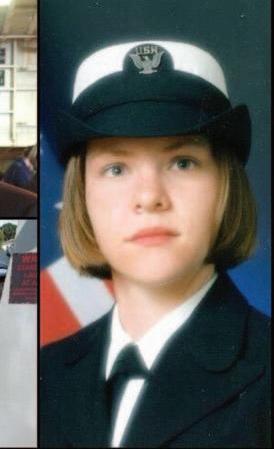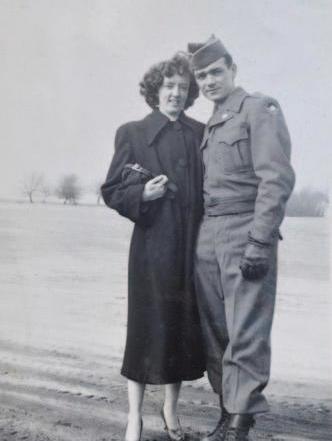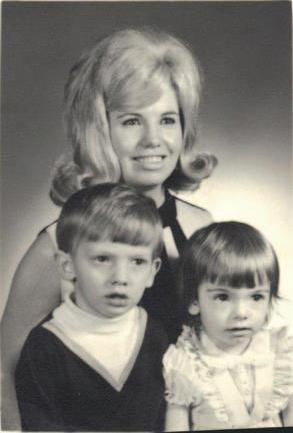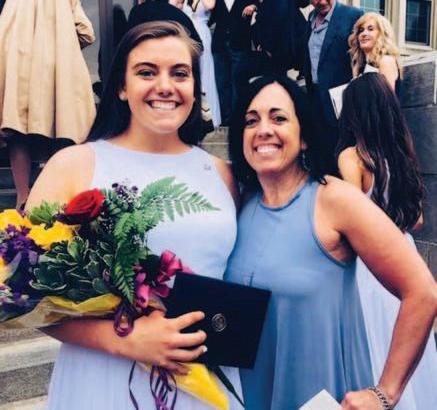
37 minute read
Land of the Free
Celebrating Military Moms
HHHHHHHHH


In May, we celebrate
mothers and nurses and with the observation of Memorial Day, we remember military members who have passed on. In this issue, Happenings takes a peek into the lives of mothers who have served their country before and after starting their families. Our military moms deserve recognition for their service, as well as their dedication to their families. Also read about a mom of a new enlistee as well as one daughter who remembers the sacrifices of not only her father, but the mother who cared for her family while her husband served.

Darlene McCurdy,
Hillsgrove, served in the Army National Guard for 30 years; 15 years under Title 32 at the State level and 15 under Title 10 at the Federal level. She saw duty in the Persian Gulf during wartime and commanded a battalion for a year in Iraq. Darlene joined the ROTC in college and enjoyed it. She went to airborne school in 1981 and decided to join the Army National Guard. She was commissioned in 1983.
She was married for 13 years;
and the Moms who Support their Military FamiliesHHH

to take command. “I was battalion commander for 12 months,” she explained. “We did amazingly well; I was so proud of our work together.”


During her deployment, Darlene’s eldest daughter, Corcynthia, came home from college to stay with her

she and her husband had dual military careers. They had four children. Darlene transitioned to active duty in the Medical Service Corps in 1999, after their divorce.

“We were a missionfocused family,” she said. “We learned teamwork, trust in the team and leadership.” In a highlight of her career, Darlene was in Kuwait when she got a call from the General. The battalion commander deploying to Iraq had been relieved and Darlene was ordered to Iraq “Life is so different than I ever imagined, due to external circumstances,” she said. “I was so used to being on the other side. I’ve been learning a new civilian way.” Her eldest daughters are married to military men. Both have served in the military. Her second eldest, Mikayla, serves in the Army Reserve as a Military Police Officer and has four children.

two youngest siblings, both of whom were in high school. “She gave up a year of her life so I could take com"We were a mission- mand.” focused family,” she Today, said. “We learned Darlene is teamwork, trust in the retired and team and leadership." lives with Corcynthia. She had a rocky reintroduction into civilian life. She had been ill, a son in law died by suicide while in the Navy and lately her youngest daughter has had a serious illness.
Dana McCue,
Lackawaxen, served in the Air Force and the Pennsylvania Air National Guard. “I always was very patriotic and had family members I looked up to who served, so I always had the desire to join the military. When I was in high school, exploring my options, I realized I was not ready to go to college and the military seemed to be a better fit. I determined the Air Force was the best fit and I enlisted in the Air Force’s Softbook Program, which allowed high school juniors to enlist into the delayed enlistment program and leave for basic training after graduation. Enlisting into this program allowed me to select my career choice early and guaranteed me that job after basic training.”



Dana left for basic training in July 1997 and served four years active duty Air Force. “When my first four year enlistment was up, I transferred to the Air National Guard, where I finished my career of 18 years. I retired from the Air Force in 2015.”
Her career field, Information Management/Knowledge Operations Management was diverse and gave her the opportunity to work in many different areas.
“I worked at the Base Information Transfer Center at Bolling AFB and at the Pentagon where I delivered and processed mail. I also worked at our Base Health and Wellness Center and oversaw the administrative side of fitness programs.” When she transferred to the Air National Guard, she was assigned to a fighter squadron. “I worked in the
command support area, completing jobs for my commanders and fighter pilots. I did that for many years. Then our base changed missions and I worked in a squadron that required me to get a Top Secret Clearance that was a detachment of Ramstein AFB in Germany. We were responsible for being war planning experts in our fields for real-life military events.” Dana grew up in a small town in Elk County “so working at the Pentagon was never anything I imagined for myself. It was an honor to work there. My years working with Fighter Pilots gave me an eye-opening view into how demanding their roles were, so I treasured the opportunity to work in that position.” While stationed at Bolling AFB, she was selected to participate in the 2001 inauguration for President George W. Bush. “I was 21 and participating in such a historical event was one of the highlights of my career. It was an honor to serve this great nation. Every time I wore my uniform, I was proud. Being able to retire from the Air Force was always a goal of mine.” “Enlisting was hands down the best decision I have ever made. I was 18 when I left for basic training, so it taught me to be independent. It gave me the opportunity to leave my small town to travel and have experiences I would not have had. It led me to the love of my life. We are blessed with three wonderful children and a great life.” Dana’s husband, Dwight, has been serving in the PA Air National Guard for the last 25 years.The couple met while they were in the Air Force, stationed at Bolling AFB. They have three children: Haley, 16; Payton, 14 and Liam, 9. “My children were born while I was in the PA Air National Guard. Being a military mom helped me be the mom I am today. We have three core values in the Air Force: ‘Integrity First, Service




Before Self, and Excellence in All We Do.’ Living by those values helped me realize how important those values are. I made sure to instill them in our children. It’s important for me to be a role model for my children and for them to see that it is important to always be ethical, work hard, try your best and follow your dreams.”

“Raising our family as a “single” parent while my husband was deployed for months at a time while I was working and serving too is always challenging and tiring, but being able to do that and show my children that sometimes you have to sacrifice for the better good and try your hardest even on the most tiring days are lessons I hope will live with them forever.”

Linda Sue Fleming Cooney,
Roaring Brook, and her siblings, Sheryl Ann Fleming Hunt, Memphis, Tennessee and Deborah Kay Fleming Rosen, Raymore, Missouri are the children of Jack Jerald Fleming, CWO4 and Harriet Jean Rudy Fleming. Their parents met on a hayride in Columbia, Missouri. “He thought she was cute and she thought he was too fast.”

Her father enlisted in the Army Air Corp. at 17 during WWII. He was assigned to a radar unit which was brand new at the time, Linda said. “When Daddy came back, he contacted my grandmother to find out where Mom was. They had corresponded sporadically, but because he was always on the move, communication was sparse. Mom was working as a telephone operator in Independence and he went up there and was waiting for her when she came home from work. He proposed and gave her a diamond ring with diamonds he had bought in Germany. Daddy had been a POW in Belgium and carried the diamonds for her ring in his sock during the war. I have them in a ring today.” After they were married, Jack was sent to Biloxi, Mississippi with the Air Force to train pilots in the field of radar. “My father was military to his bones, an officer and a gentleman,” Linda said. “In my memory, we were sta-
tioned at seven bases, not counting when we lived with grandparents,
aunts and uncles when Daddy was assigned remotely.” Linda said her mother made the most of life’s circumstances with her own personal brand of wit and humor. “She was the craftiest person I ever met and she celebrated life with gusto. She joined my father in Germany when he was stationed there after the war and they lived in a castle. Mom had great stories.”
When her father was sent to Okinawa, her mother transported three girls, ages 9, 7 and 3, across the country on crowded trains, from Kansas City to Sacramento. The middle sister was motion sick and the family could not stand in the long lines to get to the dining cars. “Mom finally took one of the conduc-
tors aside and he brought crackers so we could stand in line and Sherry’s stomach could handle the motion. Mom was in a dress, full makeup, hose, high heels and latex girdle. In that latex girdle was my parents’ entire savings. That's how we got to where we were going.” Jack and Harriet enjoyed retirement before they passed on. “They had a condo near Silver Dollar City, Branson, Missouri. Mom was a gourmet dessert chef, at least in my mind. My Dad became very involved in the community where they retired and became the parade marshall of the event that tied civilians to the military community. He always got to take the grandkids in his Model T Ford in the first car and set off the fireworks that night.” “Mom developed dementia and moved to a retirement home, but loved to shop. She would set off the fire alarm, purse in hand and walk down the highway to the Dollar Store. She was a piece of work.”

Jack died in 2002 and Harriet in 2016.

“Mom and Dad meant the world to me. I still weep at their passing and would give anything to just have one hour with them again.”
Carolyn Renn Meredick,
Scranton, is originally from Garden Grove, California. She served in the US Navy Reserves from 1987 to 1990. Carolyn graduated high school early and entered the Navy under the early entry program. She was a hospital corpsman cross trained to Personnel Specialist. After basic training, she was attending additional training schools along with a fellow service member she had become friendly with. Michael Meredick, from Scranton, was doing the same with his friend. “They fixed us up on a blind date and that was it.”

Carolyn is married to Michael. When they met, he was in the US Naval Submarine Service, working as a Sonar Technician and Digital Electronics Instructor on the USS Ulysses S. Grant SSBN. “After less than four weeks of dating, he asked me to marry him and I said "yes.” Because I had to return to California to report to my unit and start schooling, we eloped and were married on June 1, 1987. Our friends who introduced us were our best man and maid of honor.”
“I returned to California on June 3 and he remained in training in Florida, then went for training in Chicago. We did not inform our families until six months later. It was shocking, but they were happy for us and celebrated on each coast.”

Her best memories in the Navy Reserve involve serving the country, meeting fellow service members and others she keeps in touch with. “My service taught me to adapt and overcome. The highlight was meeting my best friend and the love of my life, my husband.”
The Meredicks raised their family in Scranton. “Because our son, Matthew, was four going on five and I was pregnant with our daughter, Allyson, who currently serves in the US Army Reserves, we thought the best decision was to raise our family

in Northeast Pennsylvania. NEPA has been a great place to raise and educate our children. I am fortunate to have close friends who are family.” Carolyn’s parents divorced and both remarried. Her mother, Nancy Lee Renn Seelye passed away six years ago this Mother’s Day weekend, but her dad, Judson Renn Jr. lives in California. Carolyn’s in-laws, Carol and Jerome, Taylor, have “always been supportive and loving,” she said.

Matthew is a graduate of Scranton Prep and earned his undergraduate and master’s degrees at University of Pittsburgh. Allyson graduated from Holy Cross High School and joined the U.S. Army Reserves under the early entry program at 17. She is a culinary specialist on active duty training to cross train to a petroleum lab specialist. She is also employed as a staff accountant for a bank and is continuing her education.

“Mike and I were like a Hallmark movie, love at first sight. We have always shown each other respect and have had open, honest communication. We have grown up together -- I had just turned 18 and he was 19 when we married. We had to work through long periods of being apart and no communication. There were financial struggles, raising children, loss of family and friends, but we kept our faith and supported each other. We live by the words “trust, honesty, communication, live, love and laugh.”
Shirley Siegendorf Leff Glassman

prioritize tasks. I worked, raised my children and was happily married for 53 years. I was a career woman and a feminist in the 1950s before the term existed. Thank you ‘Uncle Sam’ for my Army education.” Shirley met her husband, Paul Glassman, in 1947, while attending nursing school. He passed away in 2000.
Service runs in Shirley’s family. Her eldest son, Armand, is a Marine. He served 25 years in the Marine Corp Reserves. Her younger sister, Lila is a was in the US Women's Army nurse as is her daughter, Corps for three years from Sharon and her grand1943-46 as a medical techni- daughter, Yael. Several first cian. She was stationed at a 5,000 bed military hospital and provided direct patient care to wounded GIs fighting in the Pacific Theater. "I was a career woman and a feminist in the 1950s before the term existed. Thank you ‘Uncle Sam’ for my Army education." “The attack on Pearl Harbor had a major effect on me,” Shirley said. “I felt it was my patriotic duty to serve my country in time of war. My mother, a small business owner, raised me to be an independent woman. My guy friends were being drafted or were enlisting. Why shouldn’t I? The Medical Wing of the Women's Army Corp. was recruiting. I always wanted to be a nurse so I jumped at the opportunity to enlist.” “I had a 48-year career as a registered nurse while married and raising three children. The discipline I learned in the Army taught me how to be organized and to cousins and their children are nurses too. “I am proud to be a role model for them,” Shirley said. Shirley has three grandchildren and six great grandchildren. She passed on
her information for this story through her son Carl, the second youngest of four sons and one daughter. These days,


at 96 ½ years young, Shirley splits her time between Bucks County, Pennsylvania and DelRay Beach, Florida.


Shirley shared this special memory: “As an Orthodox Jew, I observed kosher food practices. I only ate the vegetables and starch in my mess kit, trading the ‘mystery meat’ for additional veggies. I befriended many G.I.’s this way.”
Nicole Hansen,
Enola, joined the Navy after a year of community college. “I didn’t want to go into debt with loans, so I thought joining the Navy would be a good idea.” She served on active duty for 25 years from August 1994 to September 2019. Nicole served as both enlisted and as an officer. She was onboard the USS Theodore Roosevelt (CVN 71) and was deployed immediately after the events of September 11, 2001. Nicole’s husband, Jayson Hansen, served in the Navy from 1994 to 1998. They will be married 24 years in June. “He was also a Personnelman; although we went to boot camp at the same time, we met while in school for our Navy jobs. We did not date then, but met again through friends while stationed in Norfolk, Virginia. We started dating and the rest is history.” Nicole has many memories of serving with “amazing Americans. By far some of my most memorable events are being able to see the world. I was able to see some great historical places, but the most memorable was my trip to Cairo. I was also lucky to have lived in Greece for a year and visited numerous other places during port visits, including Spain, Portugal, Scotland, Ireland, Italy, Dubai, Bahrain and Oman. The Navy allowed me to see the world and meet people from diverse backgrounds. I appreciate the life and opportunities the Navy has afforded me and my family. It was an honor to serve and I

am blessed that I was able to serve for 25 years.” Both of their children were born while Nicole was in the Navy. “It was extremely hard to leave them when I had to go out to sea for days, weeks or months at a time while on deployment. When they were both 2 years old, I was deployed the majority of that year. With our daughter, I left for an eight month deployment on her second birthday (our son was 8). It was extremely hard being away from them, but my husband held down the homefront and took care of the house and family while I was






away. I was occasionally able to Skype while on deployment, but that was only one or two days a month while the ship was in port, if I was lucky enough to find a strong WiFi signal. I will be forever grateful for his love and support during my time in the Navy.” The Hansen children are Chris, 17, and Caitlyn, 11. Nicole said: “In some ways, I was more indulgent than I would have liked to have been or than I am now, especially after I returned from deployments, perhaps because I felt that I had
missed out on so much
while I was away.”
Alyson and Brian Reilly,
Dunmore, are the parents of Jack, Lilly, Bo and Annie. They have also become military parents since Jack graduated from Scranton Prep and contemplated a military program. “After much thought, he enrolled at Westchester University as a political science major,” Alyson said. “Virtual learning was not working for Jack and when virtual learning was announced for the second semester, he began researching military options.” A family friend who is a colonel in the Army sat with him and discussed opportunities available that would accommodate his college program with military training. Jack decided on the Army National Guard.” He enlisted and started basic training in Ft. Benning, Georgia on January 3. His 22week program consists of basic training and advanced infantry training. One of his toughest assignments has been “the forge,” a four-day "As his mom, I cherish the 20-minute phone calls each Sunday and hope for good spirits on the other end of the line."
line. Thankfully, he continues to be optimistic and confident in his decision,” Alyson said. “We are incredibly proud of him and thank him and his fellow soldiers for their service to our country.”

exercise that requires trainees to sleep outdoors in a fox hole and includes tasks such as a 12-mile hike over steep terrain while carrying 50 pounds of gear. “Military service is something I have always admired and have been interested in,” Jack said. “The opportunity to supplement my education with military training will be beneficial for years to come.” “As his mom, I cherish the 20minute phone calls each Sunday and hope for good spirits on the other end of the “Graduation will take place June 11 and we will welcome him home shortly thereafter. In August, he will return to Westchester, but continue as a National Guardsman for six years.”
Catherine O’Malley Ruane


This feature wouldn’t be complete without the recollection of Catherine O’Malley Ruane, the mother of James Ruane. James’ beautiful photographs show up in the pages of Happenings. James told us that Catherine and his father, Cpl. Robert J. Ruane met at a dance when Robert’s cousin bet him a dollar that he couldn’t get a dance with Catherine. He did and “never left her alone again,” James said, except for his Army service in Korea with the 24th Infantry division. Robert was a Forward Observer with the heavy mortar company on the front lines. “He was a Forward Observer with the 21st Regiment observing what was going on,” James explained. Catherine sent Robert photos of herself but they “would get ruined,” she said. So her girlfriend asked her jeweler father to make a ring with Catherine’s photo in it. Robert wore the ring on his little finger. The Ruanes had five children. Robert died in 2012 after 59 years of marriage. Catherine lives with James. Happenings thanks the men and women who so graciously gave us a look into their military careers, their families and their life's work. We thank you for your service and your recollections. H
–Christine Fanning



Every year, Americans celebrate Memorial Day on the last Monday of May to commemorate the American soldiers who
have died in battle over the years. Memorial Day started off as “Decoration Day” on May 30, 1868, after the Civil War. John A. Logan, a general in the Union army, created this holiday to honor the deaths of the American soldiers in the Civil War. It is rumored that he originally chose May 30 because it did not fall on any Civil War battle anniversaries, but historians also suspect that he chose this day because the flowers were blooming by then. It was originally called “Decoration Day” because people honored the soldiers by decorating their graves with flowers. Records show that a group of freed slaves in Charleston, South Carolina organized one of the earliest Memorial Day celebrations. They commemorated the lives of Union soldiers who died because of the terrible conditions of a prisoner of war camp at an old racetrack. The Uniform Monday Holiday Act of 1968 changed the date from May 30 to the last Monday of May to give federal employees a three-day holiday. During World War I, the holiday grew to encompass the lives of American soldiers lost in every war, not just the Civil War. World War I also inspired wearing red poppies for the celebration of Memorial Day because of a poem, “In Flanders Field” by Lieutenant Colonel John McCrae, about soldiers buried under poppies. Americans celebrate the holiday by visiting cemeteries and memorials, taking a moment at 3 p.m. to remember the soldiers, and putting their flags at half-staff until noon. As Memorial Day is the unofficial start of the summer season, barbecues also mark the day. Truly, Memorial Day is a special holiday that gives rightful commemoration to the brave men and women who have bravely sacrificed their lives for America. -Kayla Binner



Mother’sDayPast

The late Helen Wolfe with Sally Wolfe Hines, 1943
The late Anna D. Mostek with Audrey, Frank W. and Lois, circa 1948



Marie Sarafinko (Mrs. Walter Sarafinko)
with Walter and the late Kathy Sarafinko, 1966 The late Marion Dwyer O’Brien with William F. and Patricia O’Brien, 1944 The late Cecelia Tolerico with daughters, Judy (Tolerico) Gretzula and Marianne (Tolerico) Heisler, 1959




The late Winifred (Winnie) Golden Kegley with The late Eileen Kegley Gilroy, 1933 Loretta Guarina with Lori Bortree, Marilyn Culkin, Lenette Solano, Linda Materazzi, 1958



The late Maryjane McCarthy with Phil and Les McCarthy and their late Aunt Jane, 1971 Elizabeth Yurkovic with Joanne Arduino, 1959





The late Beulah Reynolds with Griffin Norman and Cindy Gail Reynolds, 1951
Anne Marie Sysko

Post Acute Medical (PAM) Specialty Hospital
Post Acute
Medical (PAM) Specialty Hospital in Wilkes-Barre is an acute care facility that accepts patients with complex comorbidities. They offer a variety of services to assist patients in reaching their full potential. Anne Marie Sysko is the Director of Quality. She received her bachelor’s degree in nursing from Misericordia University and a Master of Healthcare Education from King’s College. She is a registered nurse and has held various positions in local healthcare. In her free time, Anne Marie enjoys spending time with family, cooking and traveling.
Photo: Michael Straub
Discuss your role at PAM Specialty Hospital.
I interface with provisional staff, both external and internal and demonstrate expertise with quality assurance, compliance standards and process, rehabilitation and managed care. I also manage state and federal regulatory compliance, outcome management and patient rights and advocacy.
What led you to pursue nursing and healthcare administration?
As a daughter of a funeral director, I grew up in a family business dedicated to serving community needs. I chose nursing to continue the family tradition of service.
My years of clinical nursing practice lead to an advanced degree in healthcare administration. This allowed me to ensure effective administration and quality care.
How do you ensure that you’re practicing good leadership habits?
Healthcare is challenging. I strive to lead by example, follow evidence based practices and continuously monitor and trend our clinical outcomes.
Discuss the collaborative disease specific cards you designed.
A few years back, one of our corporate executives asked me and a colleague to develop clinical marketing tools to share with hospitals in order to promote services we offer. We developed collaboratives for COPD, congestive heart failure, wound care and ventilator manage-
ment. Those tools are now used company wide.
Discuss the Lean Six Sigma project you lead.
Lean Six Sigma is a program that aims to maximize efficiency by utilizing a collaborative team effort to optimize performance and growth by removing waste and reducing variation. It provides a framework for organizational culture change. As a Green Belt in LSS, one of the assigned projects was to decrease turnaround time for emergency department patients who required a CT scan. We were able to significantly decrease the turnaround time, which proved advantageous for patients and ED flow. LSS remains my guiding principle for my project improvement endeavors.
Out of the many positions you have held in nursing, which has been most fulfilling?
My critical care experience; it demanded clinical skill and collaboration among colleagues with the goal of a positive outcome.
Which future projects do you hope to execute?
A Joint Commission Accreditation and achieve Disease Specific Certifications. e.g.: respiratory management.
How has the pandemic affected how you do your job?
It has challenged and elevated our ability to communicate critical data to regulators, patients and families.
What aspect do you love most about your job?
I enjoy our Patient Partnership Program wherein we are assigned patients and socially interact with them and their families on their road to recovery.
How has the position as Director of Quality influenced your personal life?
It has increased my understanding that quality healthcare extends from the bedside to the boardroom. H

Kari Machelli, RN

For nurses like Kari Machelli,
RN, the job of helping patients is not confined to the walls of a doctor’s office or hospital. Consider, for example, what happened when an elderly patient recently needed to be evaluated.
“She’s 94. She doesn’t have a computer or smartphone,” says Machelli, a longtime nurse and leader at The Wright Center for Community Health, which operates a network of primary care clinics in Northeast Pennsylvania. “I drove to her home and held my phone in front of her so that she could be seen by a physician via telehealth.” This approach – a Digital Age twist on traditional house calls – represents one way healthcare is rapidly extending into people’s homes. COVID-19 caused some patients to shy away from in-person office visits, leading to a surge in the use of telehealth. Likewise, remote patient monitoring devices that track vital signs (such as blood pressure and heart rate) and other in-home care management tools are becoming the norm. Machelli is The Wright Center’s associate vice president of integrated primary health services, a position that allows her to keep her finger on the pulse, so to speak, of these trends while staying true to her calling: providing compassionate, face-to-face care. From the time she was in nursing school at Penn State in the 1990s, the Taylor native and current Blakely resident knew she didn’t want to work in a hospital. She preferred a setting in which she could get to know patients personally. “I give my patients my cell number,” says Machelli. “They can call me if they have any issues. I feel good knowing that they know I’m here for them no matter what, even on weekends.” As her career progressed, Machelli, who is married and has two teenage daughters, has shouldered more responsibility. Today she oversees a variety of healthcare professionals, all of whom work as a team. Among the initiatives on which she and her colleagues are focused include helping patients with two or more chronic conditions, including diabetes, by supplying them with inhome monitoring devices. Care team members train patients to use the devices and then coach them on lifestyle modifications to better control issues like blood pressure and weight. This grantfunded project is one of several underway at The Wright Center. They also collaborate with The Wright Center’s behavioral health workers to ensure patients with substance use and other disorders are connected to primary care services. Traditionally in the nation’s healthcare system, the primary care and behavioral health fields operated separately, often to the detriment of patients. The Wright Center continues to work toward fully integrated services, so patients have a single venue for all healthcare needs. Machelli and her colleagues are focused on deploying a team of community health workers whose role is to assist patients in meeting basic needs (food, housing, clothing, etc.) so patients have the capacity to prioritize and address their health needs. These workers have succeeded in linking certain patients to jobs, health insurance, GED programs and other life-enhancing services. Today’s emphasis on providing wholeperson care is a far cry from what Machelli studied in nursing school. Back then, the Riverside High School graduate assumed her workday might include drawing blood and helping a physician with procedures such as patching a patient’s lacerated finger or removing a mole. But her job involves much more; it takes her outside typical care-delivery sites and involves issues far beyond a patient’s immediate health problem. One thing, however, is unchanged: Machelli’s desire for face-to-face interaction with those she serves. After aiding that 94-year-old with a telehealth visit, Machelli returned to the home a few days later and repeated the process, so the woman could meet virtually with a specialist. “It’s rewarding to help patients,” she says. “They’re so appreciative.” H



“May” you be “May” you be A s a personal trainer and nutrition coach, my goal is to provide the best guidance and motivation to clients so they can be as physically and mentally healthy and active! healthy and active! healthy as possible. I find this easy to do through my passion for fitness and nutrition. However, it is not always easy for clients to stay on track. We have so many tempting options for take-out or drive through food. With our busy lifestyles, we sometimes tend to opt for the grab-and-go over preparing a homemade meal out of convenience.

As a mom, I taught my kids how to eat healthy. I have set a good example by having lots of veggies and fruits and plenty of lean meats such as salmon, chicken and turkey. I stress the importance of starting the day with breakfast, including some protein such as a shake, eggs or a Greek yogurt. We love pizza nights and have always had snacks around, but the key is balance and moderation. Don’t overindulge. Portion size is important. Put chips and popcorn in a bowl versus bringing the whole bag out. Teach kids early so they form good eating habits.


I have always encouraged my kids to be active and to include exercise in their day. Sports are wonderful for kids. Team sports are popular amongst young children, but individual sports can be done through adulthood. Encourage both! Set good, healthy examples for kids and live a lifestyle that promotes activity and good nutrition. Go on a family bike ride when at the beach instead of sitting at a pool or beach all day. Go for morning or evening walks. Spark up a family game of volley ball or wiffle ball. Kids love engagement and it is fun for the whole family. May includes national recognition for stroke awareness, mental health awareness, High Blood Pressure Education Month, Physical Fitness and Sports Month and National Bike Month, to name a few. Exercise comes in so many forms; it does not have to be intense and intimidating. Where the mind goes, the body will follow. If you would like an exercise or nutrition plan, I would be happy to get you started! H

–Jackie Kerekes/The Training Loft
Red, White and Blue Smoothie Bowl
Always use frozen fruit for smoothie bowls. It creates a thick consistency, similar to soft-serve ice cream.
Use just enough milk to get the blades on your
Ninja or blender moving. Add more if needed.
Smoothie bowls melt, so add toppings and enjoy right away!
Ingredients:
3 frozen bananas (peeled prior to freezing) 1 cup frozen blueberries ⅔ cup unsweetened almond milk (or any non-dairy milk) 2 tbsp chia seeds (optional) 1 scoop vanilla protein powder Toppings: ½ cup fresh raspberries, ½ cup fresh blueberries, coconut flakes
Blend frozen fruit, almond milk and protein powder in a high-speed blender, food processor or Ninja until a thick, smoothie consistency. Transfer to a bowl. Top with raspberries, blueberries and coconut flakes. *Recipe makes one large or two small smoothie bowls.
Ellen Edmondson, RN
Education: Luzerne County Community College and Penn State Hometown: Kingston Family: Husband, Glenn; sons, Eric and Jacob
Ellen Edmondson followed in her family’s footsteps: her sister as well as two of her aunts are also registered nurses. Ellen started her career at Keystone 36 years ago as a staff nurse. She was Assistant Director of Nursing for 12 years and is now the Health Services Coordinator. She cares for individuals with autism and intellectual disabilities and ensures they receive the care they deserve. “My favorite part of working at Keystone is using my experience to be a spokesperson for individuals who may not be able to speak for themselves,” she explains. “My proudest moment this past year at Keystone was heading the Covid Vaccination Clinic, where we helped vaccinate 240 individuals and 150 staff.” This year has been challenging, but Ellen and the whole Keystone Health Services team worked hard to keep individuals they serve and staff healthy and safe.
Describe your responsibilities at Keystone.
I oversee the health care of 240 individuals and execute care plans created by their medical providers. I manage the Keystone Health Services team, comprised of 11 LPNs and RNs, which are an integral part of the day to day support of Keystone’s residential group homes.
How has caring for folks with autism and intellectual disabilities changed over the
years? Early recognition, newer medications, as well as behavioral therapies help to support individuals diagnosed with autism.
What should people know about autism?
People with autism often need consistent routines and caregivers should be attentive to non-verbal cues.
How do you use your experience to speak for those not able to speak for themselves?
Being observant for non-verbal cues that may signal an underlying medical condition. Keystone’s mission is to provide high-quality, gentle, compassionate, evidence-based care to help people reach their goals and live rich lives.
What has been your favorite career experi-
ence? In the beginning of my career, Keystone had an overnight summer camp in Gouldsboro that offered a camping experience for individuals with intellectual disabilities. I was part of the nursing staff that supported the medical needs of these individuals, so they were able to have a camping experience in a healthy environment. H

Photo: Michael Straub
Cheryl Friedman, CRNP, SANE-A, SANE-P Children’s Advocacy Center
Cheryl Friedman, CRNP, SANE-A, SANE-P, is a nurse practitioner on the CAC medical team.
She conducts forensic medical exams and evaluations on children, from infancy to 18 years old. Cheryl is also a member of CAC’s Multidisciplinary Team. Additionally, she provides community-wide child abuse education and developed a puppet program to help adolescents with special needs learn about sexual education and child abuse. Cheryl is a member of the Child Fatality/Near Death Child Task Force and is involved in medical peer review as a presenter and a participant in Pennsylvania. She also mentors nursing students in the nurse practitioner program at The University of Scranton and educates undergraduate nursing students in the community.
Describe a typical day:
When children come to the center, I watch the forensic interview. I get a medical history from the parent or guardian. I perform a top to bottom exam on the child, like their pediatrician would. The only difference is that I might use a colposcope, a tool that shines a light and uses magnification to visualize the genital area, if that is part of the disclosure of the child. It does not touch the child. I tell children that this is their body. They have a right to tell me what I can do or cannot do. I always ask their permission for every aspect of the medical exam.
Provide advice to protect children from abuse.
Teach body safety from a young age. Listen to children. Keep an open door policy for children to be able to come to parents for any reason. Reinforce this often.
Discuss the education program for teens with special needs. Does using puppets make the information more accessible?
Everybody loves puppets! The teens seem to forget that the adults are moving their mouths. They are focused on the puppets and pay attention to the puppet’s messages.
What is the most fulfilling component of mentoring nursing students?
Many have never interacted with special needs students. They are often surprised how wonderful the students can be.
How has CAC impacted you as a mother?
I use my skills as a mother every day. Sometimes I have to use my “mom voice.”
Sometimes I have to use caregiving skills to provide a hug or encouragement for a child.
What lessons have you learned from children at
CAC?
Children want to be believed. Sometimes talking about something that is difficult to speak about makes you feel better.
How do you protect your mental health?
Walking my dogs, swimming and taking strength training class on Zoom. I have a wonderful, supportive husband who encourages me every day!
Personal:
Education: Bachelor’s degree in elementary education, master’s degree in special education, Bachelor of Science in Nursing, Master of Science in Nursing, Certifications in SANEP and SANE-A (Sexual Assault Nurse Examiner for children and adolescents/adults)
Hometown: Scranton
Family: Husband, Michael; daughter, Rachael; son, Casey and Boxer dogs, Pudgy and Pearl
Community Involvement:
Attend all CAC events, I am a member of two community boards and I donate blood as often as allowed. H






